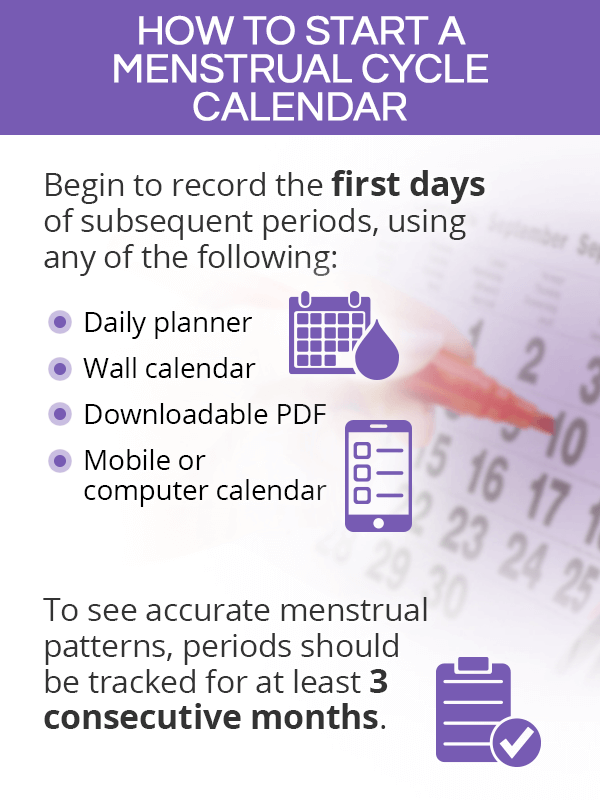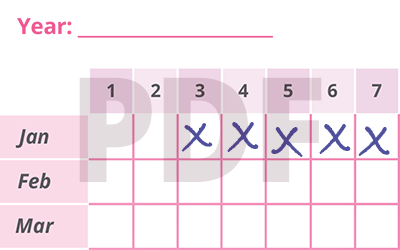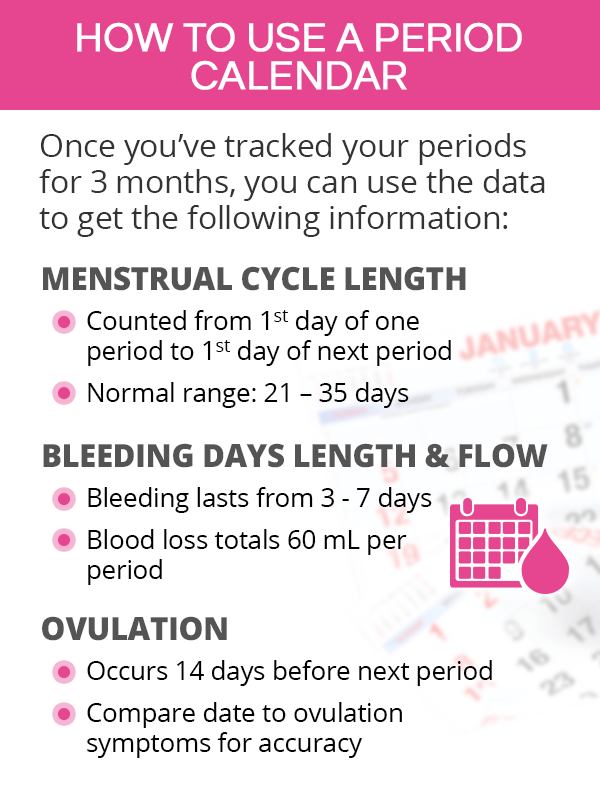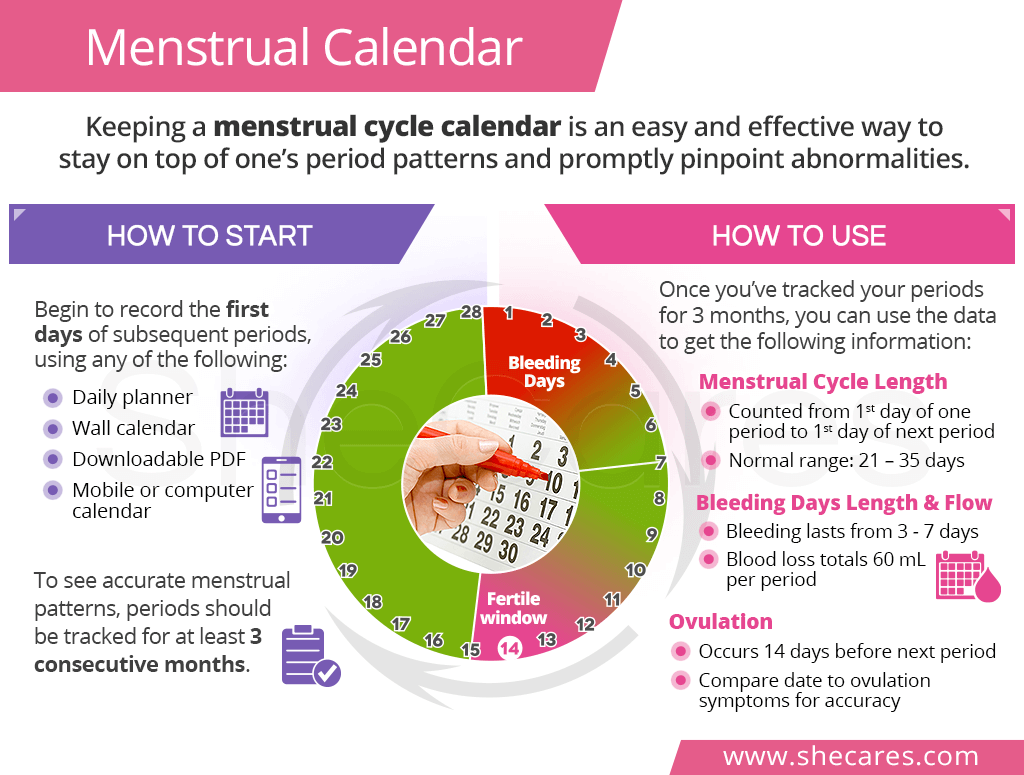About Menstrual Calendars

A menstrual calendar is simply a record of the dates of a woman's periods over time. To see reliable menstrual patterns, it is recommended that a woman tracks her periods for at least three consecutive months.
In essence, a menstrual cycle calendar is similar to an ovulation calendar, with the exception that the latter is mainly popular among women preparing to get pregnant and wishing to estimate their fertile days more precisely. The former can be used by women throughout their menstruating years.
Starting a Period Calendar
Starting a period calendar is simple and, basically, consists of scrupulously taking note of the first day of one's periods. Additionally, a woman can also mark the duration of her bleeding days.

Depending on a woman's personal preference and lifestyle, she can use the following for period calendars:
- Wall calendar
- Daily planner
- Downloadable period calendar (PDF)
- Mobile or computer calendar
Women may also choose to dedicate a separate page in their personal agenda to list the dates of her periods.
How to Use a Period Calendar

Once a woman has been recording her period dates for at least three months, she can use the data to understand her menstrual patterns. Potential abnormalities should be promptly consulted with a gynecologist to pinpoint the underlying cause, which, most commonly, is hormonal imbalance.
Using a period calendar can help a woman gain the following information:1,2,3,4,5
Menstrual Cycle Length
From her period calendar's recordings, a woman can calculate the length of her menstrual cycle. This is done by simply counting the days between the first day of one month's period until the first day of the next month's period.
This will let her know if her cycle falls within what is considered a healthy menstrual cycle, defined as one that lasts between 21 to 35 days. Lengths that fall outside of this range are indicative of irregular periods, such as cycles shorter than 21 days (polymenorrhea) or longer than 35 days (oligomenorrhea).
Length of Bleeding Days
A period calendar data will also help take note of the length of a woman's bleeding days and her flow. In the first two days, most women report the heaviest flow, which then gradually decreases as the days pass.
For reference, bleeding generally lasts for an average of five days, with three to seven being the accepted range. Blood loss totals 60 mL per period. Shorter or longer periods may be indicative of abnormal blood loss, including losing more than 80 mL (menorrhagia) or less than 30 mL (hypomenorrhea).
Ovulation Date
Knowing one's menstrual cycle length can help a woman estimate the time of ovulation. This is beneficial for women who are planning to get pregnant as well as those who are seeking to prevent pregnancy.
Ovulation occurs about 14 days before the next month's period. It lasts for up to 24 hours and is the only time conception can occur. However, if sperm is present in the reproductive tract up to five days before ovulation, it can survive there until the egg release, potentially leading to pregnancy. After ovulation and until the next period, a woman is infertile.
Menstrual Calendar vs. Period Trackers
A popular question asked by women wanting to track their periods is the difference between a menstrual calendar and a period tracker, a mobile application that stores and analyzes period data.
While they share the same purpose of keeping record of a woman's menstrual patterns, there are significant differences between the two. Some of them are as follows:
Convenience. Period trackers are often praised for convenience, allowing to store data pertaining to menstruation in one, easily accessible place. Keeping a manual period calendar may require more diligence and self-discipline.
Privacy. Keeping a manual menstrual calendar allows for full control over a woman's privacy, whereas period trackers, being digital and owned by third parties, are subject to hacking or other privacy breaches.
Features. As opposed to calendars, period trackers come with many interactive features, including next period or ovulation predictions. They also allow recording of period signs and symptoms, recent sexual intercourse, and more.
Accuracy. Calculation errors are possible with both menstrual calendars and period trackers. For better accuracy, a woman is encouraged to use the collected data and learn her body's cues, such as ovulation signs and symptoms.
Key Takeaways
Keeping a menstrual cycle calendar is an easy and effective way to stay on top of one's period patterns. It simply involves recording the first days of subsequent periods for at least three months, using a daily planner, a downloadable PDF, or a mobile calendar. This collected data will be the base for key period-pertaining calculations, such as the length of her cycle and bleeding days, to ensure her menstruation is healthy. Keeping a period calendar will also enable a woman to estimate her fertile window with higher precision, an important skill for women wanting to get pregnant as well as those trying to prevent it. While they lack the interactive features of period trackers and require more diligence, menstrual calendars allow for greater privacy control, positioning them as a valid method of taking care of one's health.
Sources
- American Pregnancy Association. (2019). Ovulation Calendar. Retrieved June 23, 2020 fromhttps://americanpregnancy.org/ovulation-calendar/
- Medline Plus. (2020). Menstruation. Retrieved June 8, 2020 from https://medlineplus.gov/menstruation.html
- Office on Women's Health. (2019). Menstrual Cycle. Retrieved June 23 2020 from https://www.womenshealth.gov/menstrual-cycle
- The Ohio State University. (n.d.). Is it normal to miss periods? Retrieved June 23, 2020 from https://wexnermedical.osu.edu/blog/disappearing-period
- Planned Parenthood. (n.d.) What's the calendar method of FAMS? Retrieved June 23, 2020 from https://www.plannedparenthood.org/learn/birth-control/fertility-awareness/whats-calendar-method-fams
Footnotes:
- The Society of Obstetricians and Gyneacologists of Canada. (n.d.). Normal Periods. Retrieved June 15, 2020 from https://www.yourperiod.ca/normal-periods/menstrual-cycle-basics/
- InformedHealth.org. (2009). Heavy periods: Overview. Retrieved June 23, 2020from https://www.ncbi.nlm.nih.gov/books/NBK279294/
- Clinical Evidence. (2012). Menorrhagia. Retrieved June 23, 2020from https://www.ncbi.nlm.nih.gov/pmc/articles/PMC3285230/
- Better Health Channel. (2018). Ovulation. Retrieved June 23, 2020 from https://www.betterhealth.vic.gov.au/health/conditionsandtreatments/ovulation
- Cleveland Clinic. (2019). Abnormal Menstruation (Periods). Retrieved June 23, 2020 from https://my.clevelandclinic.org/health/diseases/14633-abnormal-menstruation-periods
